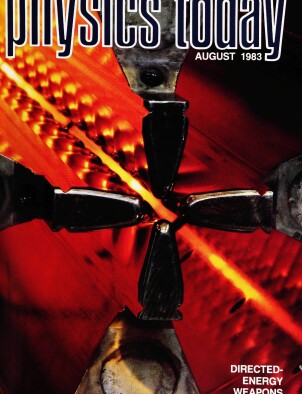Large‐N quantum mechanics and classical limits
DOI: 10.1063/1.2915799
For a physical theory to be useful, we should be able to extract from it quantitative predictions for physical observables. With most theories, this process of practical application requires some approximation method that is both tractable and adequately accurate. The lack of a useful approximation scheme can seriously impede progress in a field of research. Molecular quantum mechanics and critical phenomena, for example, have both suffered from this problem during periods of their development. The physics of strong interactions is in such a period today. Naturally, our inability to extract useful predictions from a promising theory is a strong incentive to develop novel approximation techniques.
This article is only available in PDF format
References
1. H. J. Lipkin, M. Meshkov, A. J. Glick, Nucl. Phys. 62, 188, 211 (1965).https://doi.org/NUPHA7
2. H. E. Stanley, Phys. Rev. 176, 718 (1968); https://doi.org/PHRVAO
R. Abe, Prog. Theor. Phys. (Kyoto) 49, 113 (1973).3. K. G. Wilson, Phys. Rev. D7, 2911 (1973); https://doi.org/PRVDAQ
G. ‘t Hooft, Nucl. Phys. B72, 461 (1974).https://doi.org/NUPBBO4. For recent reviews see, for example, S. K. Ma in Phase Transitions and Critical Phenomena, Vol. 6, C. Domb, M. S. Green, eds., Academic, New York (1976);
S. Coleman in Proceedings of 17th Intl. School of Subnuclear Physics, A. Zichichi, ed., Plenum, New York (1982);
Interacting Bose‐Fermi Systems in Nuclei, F. Iachello, ed., Plenum, New York (1981).5. L. D. Mlodinow, N. Papanicolaou, Ann. Phys. (N.Y.) 128, 314 (1980); https://doi.org/APNYA6
L. D. Mlodinow, N. Papanicolaou, 131, 1 (1981);
E. Witten in Proceedings of Cargese Summer Inst. on Quarks and Leptons, M. Levy, ed., Plenum, New York (1980).6. K. Hepp, E. Lieb, Ann. Phys. 76, 360 (1973).https://doi.org/ANPYA2
7. L. Yaffe, Rev. Mod. Phys. 54, 407 (1982).https://doi.org/RMPHAT
8. See, for example, D. J. Gross in Methods in Field Theory, R. Balian, J. Zinn‐Justin, eds., North Holland, Amsterdam (1976).
9. S. Wadia, Phys. Lett. B93, 403 (1980).
10. See, for example, E. Witten, Nucl. Phys. B160, 57 (1979).https://doi.org/NUPBBO
More about the Authors
Laurence G. Yaffe. Princeton University.




